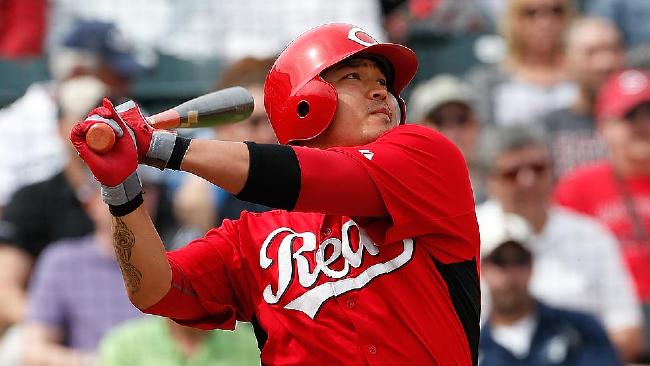
I know this probably isn’t going to be a popular opinion around here, so let me preface it by saying this — I think Shin-Soo Choo is pretty good. However, I don’t think he’s the type of player the Mets should be allocating their available funds to. I know Mets fans are clamoring to root for a winner. I don’t, however, think the Mets need to go out and spend money this offseason. Some fans seem to want the Wilpon’s to spend just for the sake of spending. Because for two plus years we’ve been told that this would be the offseason that we took a big step forward. But if you’re looking at the names available objectively, I think you’ll see there isn’t a player worth breaking the bank for.
A quick glance would suggest that Choo is a perfect fit. First, he’s an outfielder– a real need for the Mets. Secondly, he’s an on-base machine with pop and speed. What team couldn’t use that? Let’s examine.
A good place to start would be trying to figure out just how much it would take to sign Choo. Let’s compare Choo over a three year period (2011-2013) to Andre Ethier and B.J. Upton — two players who are of similar age, play the outfield and have recently signed long term contracts:

As you can see, each player has his advantages, but overall they’re very close in WAR. Choo is clearly the superior player when it comes to reaching base. Upton is the best defender of the three, and also has the better power/speed combination. Ethier is likely the most consistent player across the board; he doesn’t stand out in any category, but doesn’t kill you in any of them either. Now let’s look at the contracts signed by Ethier and Upton (according to Cot’s Contracts):
In 2012 Andre Ethier signed a 5-year, $85 million dollar contract extension. The contract runs from 2013-2017 and will pay him an average annual salary of $17MM. Ethier is currently 31-years old and his contract will run through his age 35 season. Now onto Upton.
Prior to the 2013 season BJ Upton signed a 5-year, $75.25 million dollar contract. Obviously his contract also runs from 2013-2017. BJ’s annual salary comes to $15.05MM. He will turn 33 towards the end of his contract with the Braves, making him slightly younger than Choo.
I’m feeling generous, so lets say we split the difference (almost) and go with 5-years and $80MM. That’s $16 million dollars per season. I say “generous” because I think there’s a chance Choo tops both deals. My reasons for that are because agents usually look to surpass contracts from previous seasons. Also because Choo has gotten overhyped by many baseball analysts who think that on-base percentage is what “moneyball” is.
So the question is whether Choo is an $80 million dollar player. Many will answer “yes”, since that appears to be the going rate. But go ahead and ask the Dodgers or Braves how many teams are knocking down their doors to take on those contracts. It’s also more than just a question of money. If you dig just a little deeper you’ll see that Choo is not without his flaws.
The first thing that stands out is that Choo is essentially a platoon player. Solid walk-rate aside, his numbers against left-handed pitchers have spiraled downward at an alarming rate. Here’s a look at his numbers over the past three seasons:

As you can see, Choo is hitting a meager .175 against southpaws this season. Even more unsettling is that he’s slugged just .204 without a single homerun in 169 plate appearances. To put those numbers in perspective– Choo would rank 6th in batting average and 10th in slugging AMONG NL PITCHERS (min. 50 PA). If this were one outlier season I could overlook it, but it’s been a steady decline that cannot be ignored. Essentially you’d be paying $16MM per season for a player who would hit like a second pitcher in your lineup when there’s a lefty on the mound. In a division that already features lefties like Cliff Lee, Cole Hamels, Gio Gonzalez and Mike Minor.
Another red flag is his defense. Choo has played center field almost exclusively this year. Problem is– he’s not a center fielder. The only way I can explain that is with two simple words: Dusty Baker. But that’s a whole other blog post. Let’s take a look at Choo’s defense from the sabermetric side:

In 2011, playing right field exclusively, Choo had the metrics of a league average outfielder. Playing the same position in 2012 in the same ballpark, his numbers dropped dramatically. His UZR (Ultimate Zone Rating) fell from 2.1 to -16.7 and his DRS (Defensive Runs Saved) nose-dived from +3 to -12. So far in 2013 the trend has continued. He’s on pace to surpass his lowly UZR from 2012, and his -13 DRS thus far ranks dead last amongst qualified outfielders.
I know the skeptics will say that defensive metrics are a work in progress and often flawed themselves– and they’re right. However I think they’re a reasonably reliable indicator of defensive performance. Certainly a good outfielder isn’t going to put up metrics that terrible. Not for two consecutive seasons. The sample size at this point is large enough.
In summation, I’m going to reiterate what I said to start this — Shin-Soo Choo is a pretty good player. You have to like a guy getting on base at a 40% clip regardless of his aforementioned flaws. I just don’t think he’s the right player for the Mets. He’s a great complimentary player for a team that’s a player away. He’s not a building block for a team looking to find it’s identity. Choo doesn’t posses the impact tools that the Mets need. At least not at that price. What’s a .400 OBP if you don’t have the players behind him to bring him in? I think the money could be better spent on a few players that could help in multiple spots, or even *gasp* saved for another time. There’s a great feeling around this team right now, and I don’t want to rush to sign a player who will cripple us financially in the future. We’ve been through that before. We’re finally about to get out from under that rock. Better days are nearing. Let’s get it right this time.














